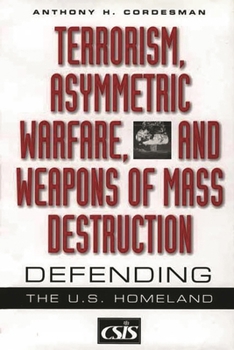Terrorism, Asymmetric Warfare, and Weapons of Mass Destruction: Defending the U.S. Homeland
Select Format
Select Condition 
Book Overview
There is a wide spectrum of potential threats to the U.S. homeland that do not involve overt attacks by states using long-range missiles or conventional military forces. Such threats include covert attacks by state actors, state use of proxies, independent terrorist and extremist attacks by foreign groups or individuals, and independent terrorist and extremist attacks by residents of the United States. These threats are currently limited in scope...
Format:Hardcover
Language:English
ISBN:0275974278
ISBN13:9780275974275
Release Date:November 2001
Publisher:Praeger
Length:464 Pages
Weight:1.90 lbs.
Dimensions:1.3" x 6.4" x 9.5"
Customer Reviews
3 ratings
Hits the nail on the head!
Published by Thriftbooks.com User , 19 years ago
Anthony H. Cordesman's Terrorism, Asymmetric Warfare, and Weapons of Mass Destruction: Defending the U.S. Homeland is a text I assign as the centerpiece for a Law Enforcement Intelligence course. This very comprehensive work covers the main elements for an actionable policy against threats both foreign and domestic. Possibly the most significant aspects of the volume are the merging of the historically polar fields of military and civilian security forces, and erasing the line between national security and foreign defense policy. Cordesman focuses less on winning the war, and more on sustaining the peace. This is accomplished by first, encouraging a government policy that the military take a lower profile, requiring the police to shoulder a greater portion of the responsibility for peacekeeping. Second, there is a much greater emphasis on special operations, which focus on the primary objective, i.e., to achieve containment and in particular limiting the appeal of the extremists to their likely sympathizers, even if total elimination may be unachievable. Additionally, the book identifies consistent, and prescient factors, which strongly influence the likelihood of success in a counterinsurgency campaign. These include, but are not limited to the following: · Geopolitical conditions, such as whether there are bordering states sympathetic to the guerrillas in order to give them a haven and a supply base. · Multiple fronts, which the government must concern itself. The availability of highly trained military and police are necessary to combat small, highly mobile or embedded guerrillas. The more entrenched, and therefore, the more legitimized the insurgency becomes, the more difficult it becomes to undermine their activities, funding, recruitment and support from the population. · Ethnic and religious homogeneity of the indigenous population. The population must be won over to support the government. · The importance of intelligence in a counterinsurgency war cannot be over-emphasized; and this includes a deep understanding and appreciation of the time and effort required to develop and cultivate sources. There is and never will be, a substitute for HUMINT. Defending the U.S. Homeland depicts a pragmatic policy comprised of a mailed fist, properly coordinated with a velvet glove, heart-and-minds campaign. Undoubtedly, guarding against future transnational crime and terrorist threats, indicate a need for greater communication and flexibility in both U.S. intelligence operations and policy.
The Textbook
Published by Thriftbooks.com User , 22 years ago
If you were to teach a graduate seminar in 'homeland defense,' you could make a strong case for using this book as your teaching text. It's an extremely comprehensive look at the topic, with sections on everything from risk analysis to the roles of various state and federal agencies. It also scores high on Buzzword Bingo -- featuring not only the title phrases 'weapons of mass destruction,' 'asymmetric,' and 'homeland' (who ever used that term prior to September 11?) but other current insider jargon like jointness, CBRN, proxies, and learning curve. Civil and military aspects of the 'homeland defense' question are all thoroughly covered.If there is a deficiency, it's in discussing the larger context in which attacks are likely to occur. Cordesman posits a world in which threats exist, and the decision-maker has to prepare for, detect, counter, and respond to them. What's missing is an analysis of why threats exist in the first place -- in the plaintive wail of the headline writers, 'Why do they hate us?' Might not finding ways to get 'Them' to hate us less be an element of 'homeland defense' as well? Assessing HOW we're at risk without also figuring out WHY strikes me as akin to trying to fix a leaky bathtub without first turning off the faucet.But within the narrower focus of Cordesman's book, he does a very thorough job. I can imagine this title showing up on a lot of desks in Washington, D.C., and that's probably a good thing.
Terrorism, Asymmetric Threats, and Weapons of Mass Destruct
Published by Thriftbooks.com User , 22 years ago
Originally I bought this book looking for information concerning National Missile Defense. It did not hit the mark, but it IS an excellent source of information on international threats to the US. I recommend it to all in the new Homeland Defense Administration and all the National Guard Civil Support Teams. Mr. Cordesman covers risk assessments, threat assessment and prioritization, types of anticipated attacks and how to respond, Federal efforts (by department and agency) to establish homeland defense, lessons learned, and final recommendations.





